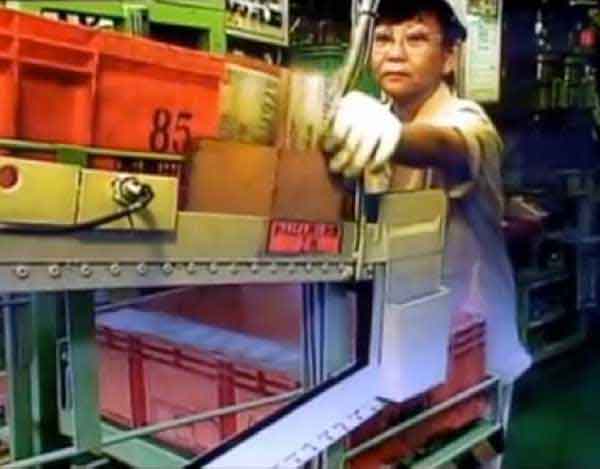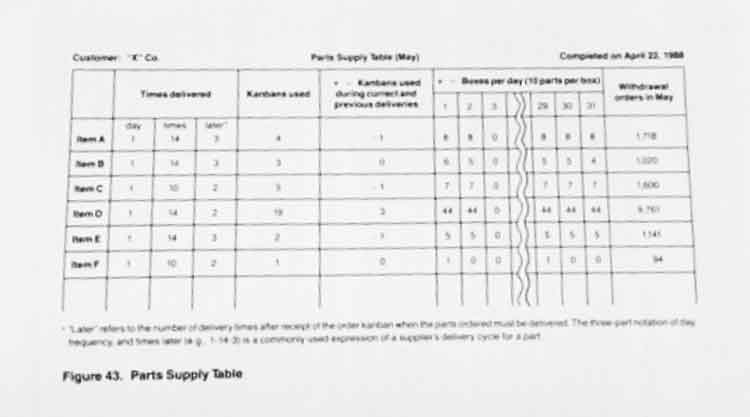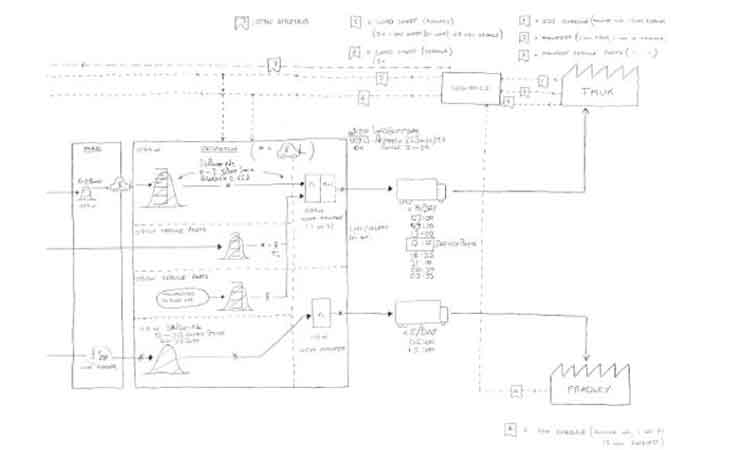The following column comes through special arrangement with the Lean Enterprise Institute. It was authored by Michael Ballé, a Lean management practitioner, business writer, and author.
I have been asked: What about lean and digital? Any thoughts? And on Industry 4.0?
Before I wade in on this, first bear with me and wait a bit before accusing me of splitting hairs. We need to make the difference between digital and digitized:
Digital is about using digits: one, two, three. Single piece flow is digital. Pixels are digital. Anything that you can count one by one is digital.
Digitizing is about converting stuff to a digital format that can be processed by a computer.
Can we agree that these are two very, very different concepts? (although, obviously, interlinked)
Any product or service for that matter can be broken down into systems, and then components, and then individual parts.
Supply Chain Digest Says... |
 |
| Millions are spent on digitizing processes designed in the batch age, that become inflexible and make team members' work harder and harder. |
 |
What do you say? |
| Click here to send us your comments |
 |
| Click here to see reader feedback |
|
|
Looking at each part singly would be digital, even if the parts aren't digitized, right? For a given company, each of these parts is produced:
1. Singly (unlikely) or in a batch
2. Right away (unlikely) or when it gets its turn in the scheduling queue (or within the batch)
3. On request (unlikely) or when it's pushed by its producer.
Think about a picture on your smartphone. It's digital, as in standalone, as opposed to a film camera. It's instant, as opposed to the film which needs to be developed. It can be shared instantly on request through social media rather than having copies made and sending them.
Kanban Counting
Even without computers, a kanban system is digital. It shows you the gap to single-part flow, it shows you the gap to instantaneous response, and it shows you the gap to a totally interlinked supply chain working on demand.
Count how many kanbans are on this waiting queue:

One box of parts is about to be made, as the team member takes the kanban card (usually about five parts), she can see the next box demanded. The cell can make the entire part.
Now check at how kanban cards are monitored:

(Article Continued Below)
|
CATEGORY SPONSOR: SOFTEON |
|
|
| |
|
|
This table looks at the frequency of delivery: the rhythm (daily), how many times a day (14), how many cards later do you get the parts you ordered (4) and how many kanban cards are in the loop.
This gives you the distance to instantaneous. Finally, a material flow map of the supply chain can show you how far kanban penetrates:

We can see on the left where the parts go into a push stock as opposed to a pull supermarket. Applied to the supply chain, we can then see how far kanban penetrates, and what are the lead-times involved, which establishes the overall distance to on demand and instantaneous.
Kanban, therefore, is a tool of digital thinking, even without any computers involved. The tool raises the three questions that drive the Amazon supply chain:
• Availability (can I order it?)
• Speed of delivery (how fast can I get it?)
• Price (is it the best buy in the category?), as kanban also reveals all the waste everywhere in the delivery process.
This is digital thinking. It's based on looking at the lead-time of every single unit, controlling it and then reducing it to reach the digital ideal of instantaneous, on demand and cheap.
Now, there is digitizing, which means translating all we do in terms that a computer can understand. ERPs, for instance, that essentially deal in moving inventories around – the basic driving calculation of any ERP is REAL DEMAND = REAL STOCK - CUSTOMER DEMAND + SAFETY STOCK in order to keep inventories at the "correct level" and, most importantly, keep machines running no matter what.
A good example of digitizing is what Elon Musk is trying to do to Toyota's old NUMMI plant, with the dream of creating a fully automated factory that works as a machine, and should deliver millions of cars around the clock, lights out, robots only facility? So far, it's not working out that well, but one thing Musk is good at is selling hope.
Musk thinking is always grand, and when he gets it wrong, it can be seen as a caricature (he did succeed in bringing back the rockets!), but really it reflects how most people think of digital: let's digitize quickly our existing processes. Truly digital companies, such as Amazon or Google, however, were digital from the start. They understood they needed to look at items one-by-one, not in batches, and that computing power could help them do that.
Interesting enough, to this date, in most established companies we struggle like mad to get information systems to work at the single unit level. Batch thinking is everywhere. Systems count in averages, more-or-less thought of distributions, but hardly ever, well, digitally.
What I've seen so far of 4.0 falls squarely into that category. People are working hard at:
• Digitizing what they have, or failing that, fitting their information systems on digital platforms the GAFA offer
• Automating processes, mostly by using IT or (I've yet to see this firsthand) Artificial Intelligence
• "Big Data" – using data to flesh out customer relationship through real data from customers, but again, this tends to aggregate customers into segments, so no real digital here
• Connect users and things through existing systems, which were built for batch.
I don't have any overall opinion on these initiatives simply because the same words refer to very different experiments, and we'll know better when the dust settles, but what I've seen so far is not that encouraging. Millions are spent on digitizing processes designed in the batch age, that become inflexible and make team members' work harder and harder as they have to manage the process as much as the work itself.
By contrast, Toyota is going full speed ahead with connectivity as it showed at the Vegas CES with its e-palette concept, as well returning to basics in their own production processes with tools designed to support human work that should be increasingly light and flexible. As Jeff Liker mentions in Forbes, they're aiming for flexible plants capable of producing eight different models in sequence (I have indeed seen this in Japan) to respond more quickly to demand. Each kanban card on the line represents the unique identity of the car:
For what it's worth, my take on it is that Toyota invented a digital system before digitizing was an option. If you want to test how digital your own thinking is, you can ask yourself, am I looking at:
• Digits: Am I thinking one-by-one or by categories, segments, averages, etc?
• Instantaneous: I am thinking now! Or am I accepting unavoidable lead-times due to internal organizational issues (it's easier for us to do it this way)?
• Connectivity: Am I connecting products with users, tools with users, users with sellers, users with users?
• Cost: Am I looking for a massive cost advantage somewhere non-obvious by being closer to one by one, closer to now!, closer to fully connected.?
And only then ask yourself how digitizing this can lead to faster, more powerful solutions – and indeed, creating digital representations with computing power can definitely help to get these four items forward spectacularly.
Lean was digital right from the start. Digitizing can either leverage lean's digital power, or, on the contrary, further burden and rigidify processes by computerizing and automating the very waste that should simply be eliminated. Where is the space for kaizen in computer systems? Again, it's all a matter of perspective. Kanbans are about digits, and kanbans are about revealing where kaizen needs to happen:
1. Kanban is late (andon pull) and the team leader needs to jump in
2. Because the team member is not fully trained
3. Or resources haven't been placed at the right place.
Or kanbans are not late, and kanbans can be pulled out of the loop to create tension and get closer to now! More kaizen.
In the end, the main difference I see between digital lean and 4.0 is the space for kaizen. This is what Elon Musk took out of the ex-Toyota plant, thinking he would out Toyota Toyota by fully automating the plant, reducing TPS to a production system and missing that the real point of just-in-time is … respect for people.
How do you see Lean and Indudtry 4.0? Let us know your thoughts at the Feedback section below.
Your Comments/Feedback
|
|
Patrice
Maintenance Manay, Company |
Posted on: Jun, 04 2018 |
|
| Great article about industrial 4.0. One way to start is be connected and get data is to choose the good application. We have started this in my automative company by getting information from sensors and back in our Maintenance Management System . The next step will be to be connected to our ERP SAP. |
|
|